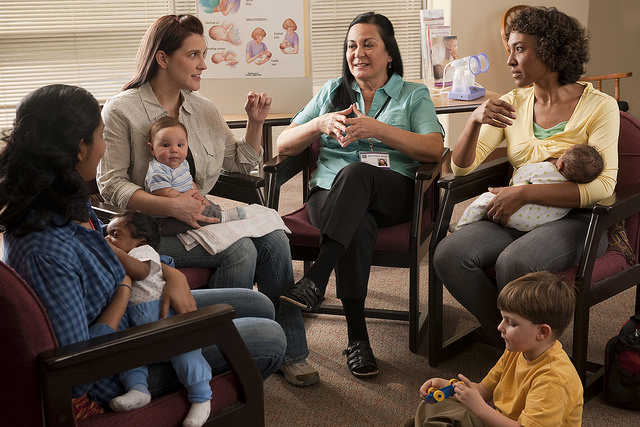
How have 14,500 Bristol babies changed science? Q&A with Suzi Gage
In the early 90s, a team from th e University of Bristol recruited 10,000 pregnant women for a study on the environmental and genetic factors that affect a person’s health and development. Over the last 26 years, these women, their children and the rest of their families have contributed to a massive set of data covering all aspects of their lives from diet to health issues and lifestyle choices such as smoking and drinking. Suzi Gage, from the University of Liverpool, joined us to talk about the project, now know as the Avon Longitudinal Study of Parents and Children (ALSPAC,) and answer all our questions.
e University of Bristol recruited 10,000 pregnant women for a study on the environmental and genetic factors that affect a person’s health and development. Over the last 26 years, these women, their children and the rest of their families have contributed to a massive set of data covering all aspects of their lives from diet to health issues and lifestyle choices such as smoking and drinking. Suzi Gage, from the University of Liverpool, joined us to talk about the project, now know as the Avon Longitudinal Study of Parents and Children (ALSPAC,) and answer all our questions.
PSG: Could you give us a brief description of what ALSPAC is all about and how it happened?
Suzi Gage : It was set up was because researchers were interested in what had the biggest effects on the health of mothers and babies. Large scale studies that follow people up over time are a really good way to look at this. Originally it was going to focus on pregnancy and early life, but then they just kept on applying for funding, and amazingly it’s still going now!
There’s actually a cool story about how it got started, but it’s a bit long to go in to. I wrote a chapter for a book on the woman who set it up. You can find out more about it here:
http://findingada.com/shop/a-passion-for-science-stories-of-discovery-and-invention/
There’s also a book about the ALSPAC journey specifically which you can read for free online – it’s really interesting (not that I’m biased!). You can find it here:
http://www.bristol.ac.uk/media-library/sites/alspac/migrated/documents/book-21-years-our-journey.pdf
PSG: Can you tell us a bit about the processes that you use to turn the raw ALSPAC data into something useful – what do you actually do?
Suzi Gage: Great question!! When I get the data from ALSPAC, I basically get a large spreadsheet – with whatever variables I’m interested in for every participant who answered that questionnaire, or gave that sample, or attended that interview. Each participant has a unique identifying number so it’s completely anonymous.
I use software called Stata to look at the data. Often what I’ll do first is plot the variables I’m interested in as a graph, in order to see what the data looks like. It’s very hard to see anything in a big spreadsheet of 1s and 0s, but if you plot them this can help.
Then I’ll work out what analyses I need to do. Often this will be some form of regression analysis because this can allow me to adjust for other factors that could be affecting the association I’m interested in.
PAG: Please can you explain what a regression analysis is?
Suzi Gage: It’s a way of looking at whether one variable (an exposure – for example whether or not a person drinks alcohol) is associated with another (an outcome – maybe whether a person has liver disease) – but it allows you to include other factors in the model as well (for example how much exercise a person does, what kind of diet they eat – or anything else you think might also be linked to whether they drink, or whether they are at risk of liver disease).
PSG: How long does it take to get from raw stats to some kind of correlation and then to something that includes accounting for other factors and still shows a significant correlation?
Suzi Gage: Hmmm – good question! It can depend really. Ideally, you’d come up with your statistical analysis plan before you look at the data, and in that case it would be quite quick. But sometimes the data needs cleaning. For example, missing data can be coded in such a way that if you just ran a statistical test straight away it would be included rather than ignored by the software – and this might depend on what software you were using as well!
PSG: So do you know what you want to look for beforehand – do you know that there’s other research pointing to a correlation between, let’s say, tobacco use in pregnancy and low birth weights, and then use the ALSPAC data to check (and have access to all the other possibly confounding variables)? Or does someone have the job of just playing around with the data and seeing what correlations come up? I’d like that job!
Suzi Gage: The former (sadly, haha!). In order to be allowed to use the ALSPAC data you need to write an analysis proposal. You look on the website at what data is available and then you apply to use it – saying what your research question is, your hypothesis and why you think that, and what variables you’d want to include in your analysis.
You can see the submitted research proposals on the ALSPAC website: http://www.bristol.ac.uk/alspac/researchers/current-research/
PSG: So after you’ve plotted your graphs and it looks like two things correlate, what next? I’m guessing you need to show how they are linked – can the ALSPAC data help you with that or is it just a starting point to lead to new studies?
Suzi Gage The limitation of ‘observational’ data like this is that it’s really difficult to be sure that, if two things are associated, one is causing the other, and work out which is which.
But there are some novel methods available that can help get at this tricky issue of causality. None of them are perfect, but if you can do a couple of them this might give you stronger evidence. And you can do some of these using ALSPAC data.
PSG: How is the project developing in terms of the data that you are collecting? Have you increased the number of questions that you are asking people as a result of your findings? And if so, how you decide which ones to add (as I assume you don’t remove questions)?
Suzi Gage: Not everything gets asked at every time point. The poor participants!!! 🙂
A lot of what gets asked depends on whether funding is available to put questions/sample collections/interviews into the schedule. It’s very important to treat the participants with respect and not take the mickey with how much time they are expected to give up for the study – after all, if they all dropped out, the study would cease to exist – they’re the most important people involved!!!
Researchers who want to ask a particular question can apply to ALSPAC to have it put in, and apply to funding bodies to pay for it. Obviously it’s expensive to send out questionnaires to thousands of people, or to invite them in for a clinic, or to collect and process thousands of biological samples!
I’ve not personally been involved in adding anything to the ALSPAC data collection – but my colleague got funding recently to add some questions about e-cigarette use to the study. Which is great, and I’m now involved in using that data as well!
PSG: Is there any data on adult mental health versus how you were put to bed as an infant? We asked another expert about this recently and learned that the (often quoted) studies looking at baby cortisol levels when left to settle alone were at an early stage and tricky to do anyway because it’s hard to know what normal is. But we wondered at the time of anyone had ever looked back at adults with mental health trouble and how they were put to sleep.
Suzi Gage Ooh. There’s data on the mums’ (and dads’ I think) mental health. I don’t know whether they were asked about how *they* were put to bed though. That’s an interesting question.
There will definitely be data on the ‘children’ though. They’re they’re adults now, and they’ve been asked about their mental health all through childhood and adolescence. I used some of this data during my PhD.
PSG: Is there is data on bedsharing?
Suzi Gage: There’s definitely data on bed sharing – my friend used it in her PhD! She wrote this for my Guardian blog a while back – it’s very interesting:
https://www.theguardian.com/science/sifting-the-evidence/2015/mar/18/bed-sharing-with-babies-is-it-safe
PSG: The official advice until recently has been against co-sleeping, so would parents have necessarily told the truth? Which leads me to the question – I assume some of the data you have is from parents’ self-reports? How sure can you be that that is accurate?
Suzi Gage: This is a really good point. We can’t ever be 100% sure that it’s accurate. If there’s just random inaccuracies, then this will make the data more ‘noisy’, but with a large enough sample size it might not be a problem. However, if a certain group of people are more likely to be inaccurate, this can introduce bias in to analyses. So this is something it’s important to be aware of when interpreting any findings from observational studies like this.
PSG: Could you give us some examples of when certain groups’ answers are more likely to be inaccurate? Although I guess the ‘worst’ ones are when you don’t realise there’s a reason for a certain group to answer inaccurately.
Suzi Gage: As a hypothetical example, say there’s a stigma around women using alcohol in some cultures, which might lead women to under-report about their alcohol intake, but not men. If you then wanted to compare alcohol use in men versus women in terms of risk of disease, it might look like women are at risk at lower levels of alcohol use, when in fact it’s because they’re underreporting but then men aren’t. Something like that…
But yes, as you say the real problems happen when you don’t know there’s bias!
PSG: Can the data look at how length of breastfeeding affects attachment, and compare the independence of breastfed children of differing durations to non-breastfed children?
Suzi Gage: I would have thought so, yes. I know there is data about breastfeeding. And I’m pretty sure there will be data about attachment/independence etc during childhood. Actually it wouldn’t surprise me if someone has looked at this…. I’ll see if I can find out! I’ve not done any research in to this myself, so I’m not sure I’m afraid (my area of expertise is more around adolescence and mental health I’m afraid!)
PSG: I’m interested in your research – please could you tell us a bit about your findings, to do with the association between mental health and lifstyle behaviours? What would you say are your “headline” findings? Did anything surprise you particularly?
Suzi Gage: My PhD looked at links between cannabis and cigarette use, and later psychotic experiences and depression. I suppose my headline findings are “it’s hard to do this type of research!” I really wanted to try and tease apart cannabis and tobacco use – but this was almost impossible. In the cannabis users in ALSPAC, most were smokers. And of the ones who weren’t, all but 3 used tobacco in their cannabis joints! So there was no chance of looking at cannabis by itself.
There were more individuals who were tobacco but not cannabis users, but they were, on average, less heavy smokers than those who also used cannabis, so this again made it challenging! I was also involved in this piece of research: https://www.theguardian.com/science/sifting-the-evidence/2016/jan/14/does-cannabis-really-lower-your-iq
PSG: Do any other countries have similar datasets about cannabis use?
Suzi Gage: Studies have been done in quite a few countries, but almost all western ones (almost all research is done in western countries – certainly the research that gets published in English, anyway, which can leave blind spots in the literature). Also, it’s worth noting that by far the largest study looking at links between cannabis and psychosis (and the first one) was done in Sweden using conscript data – so is entirely men!
PSG: I’m really interested in the association between screen time use and anxiety in adolescents – as someone who spent a lot of time online as and adolescent and now, due to social anxiety! Can you tell us a bit more about it? Why did you want to look into it and what have you/do you expect to find?
And ADHD and caffeine! – anecdotally, I’ve heard many ADHD adults find caffeine helps them calm down, contrary to what ‘neurotypical’ adults experience.
Suzi Gage: Sadly when I left Bristol I passed this project on to someone else so I’m not running that analysis any more. But I’m really interested in it – and it’s exactly anecdotal reports like that that are the reason we came up with the research question! ADHD medication is essentially a mild stimulant, and so is caffeine, so there’s a good theoretical reason that that might be the case – so good to run a study to try and investigate further!
We’re just writing this up to be published. What we really wanted to do was really try and understand screen time was replacing for people (if that makes sense). For example, are people sleeping less, or doing less exercise, or what.
PSG: Actually any real evidence based info on screen time would be so interesting. Lots of stuff flies around about this but it’s not often based on evidence.
Suzi Gage: I think this is a really good point. It’s quite hard to do this as well – because screen time is changing so much. The data we were using was from when the kids were 16 years old – so data from over 5 years ago! Screen use behaviours have changed a lot since then! Which is a challenge!
PSG: So is it the screen time, or the lack of something else that contributes to the anxiety? Or both? Is there an answer?!
Suzi Gage: These are only preliminary findings, but it seems that, in this sample at least, we found an association between screen time and anxiety. But when we took ‘time spent alone’ into account, the association between screen time and anxiety was much weaker, and statistically may not have been more than chance.
PSG: So would that suggest that time spent alone might actually be more of a predictor of anxiety than screen time? I guess that’s also a clear example of how much screen time has moved on in only five years, now a lot of technically alone-time (me right now sat on my sofa!), is actually interacting with others, albeit not face to face.
Suzi Gage: Exactly, yes! Also, we now use multiple screens at once – Tva , phone and laptop could all be in use at once in extreme examples! And *how* a person uses a screen can vary dramatically too, as you say it can be a very social experience.
These are all issues we’re having to think of when we write up the discussion section of the paper!!!
PSG: So you found that screentime/alone time was associated with more anxiety. Does that mean you don’t know whether screentime/alone time CAUSES more anxiety. Or whether people with anxiety are more likely to spend time alone/online?
Suzi Gage: We definitely don’t know anything about causality from these data. And we can’t say anything about the detail of the screen time either – so we don’t know if social screen time has a different impact to other types of screen-based activities.
One interpretation of these results might be that the reason we can see screen time associated with anxiety in the data is because people who spend more time looking at screens are also spending more time alone, and maybe that time alone is what is linked to anxiety. But in what direction that link is, we can’t tell from these results. We did look at screen time two years earlier than anxiety, and took earlier measures of anxiety into account to try and rule out this ‘reverse causality’, but we can’t be sure we’ve actually managed to really take it in to account.
PSG: Suzi, is there a master list of all the sorts of data that ALSPAC has gathered that is accessible to the public?
Suzi Gage: Here’s the cohort profile http://www.bristol.ac.uk/alspac/researchers/cohort-profile/
PSG: Has your work on ALSPAC given you a wish list of info that you’d like to see gathered? If so, what is on it and why?
Suzi Gage: Ooh! So much!! I can’t think off the top of my head though!!!
Sometimes ALSPAC can be a little frustrating in that questions can sometimes slightly alter from one year to the next. For example the cannabis questions in the questionnaire were slightly different to the questions in the interview years! Which was annoying for me when I was trying to look at patterns over the entirety of adolescence! It’s the drawback of using a pre-existing dataset – there are always questions that you’d answer differently, but the advantages of such a huge dataset are massive too!

